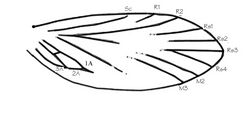Biology:Archaeolepis
| Archaeolepis | |
|---|---|

| |
| Wing venation of Archaeolepis | |
| Scientific classification | |
| Domain: | Eukaryota |
| Kingdom: | Animalia |
| Phylum: | Arthropoda |
| Class: | Insecta |
| Order: | Lepidoptera |
| Family: | †Archaeolepidae |
| Genus: | †Archaeolepis Whalley, 1985[1] |
| Species: | †A. mane
|
| Binomial name | |
| †Archaeolepis mane Whalley, 1985
| |
Archaeolepis mane is amongst the earliest undisputed lepidopteran fossils. It dates from the Lower Jurassic (ca 190 million years ago). It was found in the Charmouth Mudstone Formation, Dorset, United Kingdom.[1]
Etymology
Archaeolepis means 'ancient scale', referring to the antiquity of the specimen, and the scales (modified and flattened hairs characteristic of butterflies and moths) that identify it as a Lepidopteran. The species name, A. mane means 'dawn', further emphasising that it is the earliest known member of this group.[1]
Discovery
The fossil was found by J. F. Jackson (1894-1966) of Charmouth, and later purchased by the British Museum of Natural History.[1] The fossil of Archaeolepis was not studied until the 1980s, when it was described as a type of early lepidopteran, the family that includes butterflies and moths.
The fossil (which comprises a wing) is just over 5 mm long (0.2 inches) and 2 mm wide.
Significance
The fossil of Archaeolepis consists of wings with scales that are similar to those in lepidopterans. Recent re-examinations have backed up this conclusion.[2] When it was found it pushed the known fossil range of lepidopterans back another 50 million years.[1] This was surprising, because it had been assumed that butterflies and moths first emerged alongside flowering plants in the Cretaceous. Finding Archaeolepis in the Early Jurassic, means that the first members of this group must have originated earlier.
Similar scales to those of butterflies and moths have been found in earlier deposits from the Latest Triassic, and some researchers argue this, along with evidence from genes, provides evidence for a much earlier appearance of the group.[3][4] But the identification of these fossils is disputed, so Archaeolepis remains the oldest confirmed fossil lepidopteran.
References
- ↑ Jump up to: 1.0 1.1 1.2 1.3 1.4 Whalley, PES. 1985. The systematics and palaeogeography of the Lower Jurassic insects of Dorset. Bulletin of the British Museum (Natural History), Geology, 39: 107-189.
- ↑ Grimaldi, D.; Engel, M. S. (2005). Cambridge University Press. ed. Evolution of the Insects. Cambridge, etc. ISBN 978-0-521-82149-0. http://www.cambridge.org/us/catalogue/catalogue.asp?isbn=9780521821490&ss=fro.
- ↑ van Eldijk, T.J., Wappler, T., Strother, P.K., van der Weijst, C.M., Rajaei, H., Visscher, H. and van de Schootbrugge, B. 2018. A Triassic-Jurassic window into the evolution of Lepidoptera. Science advances, 4(1), p.e1701568.
- ↑ Wahlberg, N., Wheat, C.W. and Peña, C. 2013. Timing and patterns in the taxonomic diversification of Lepidoptera (butterflies and moths). PLOS one, 8(11), p.e80875.
External links
Wikidata ☰ Q4034280 entry
 |

